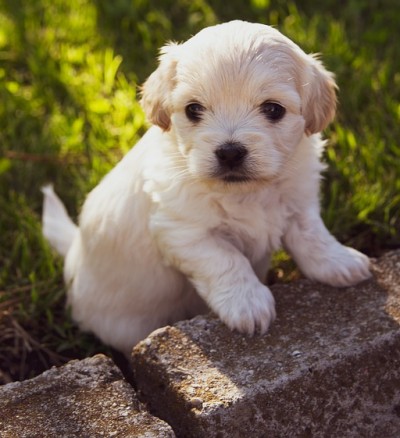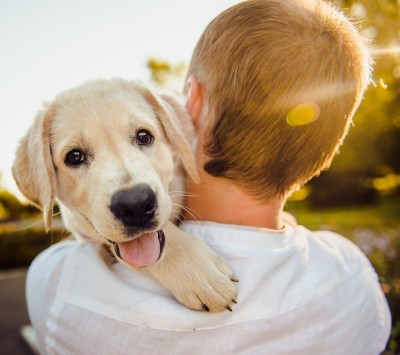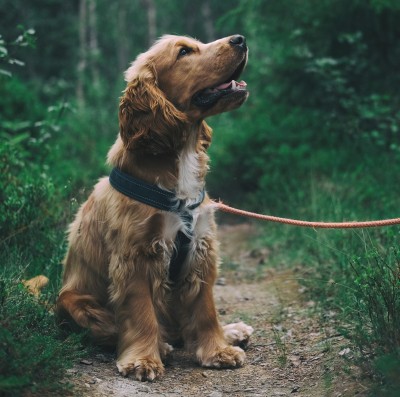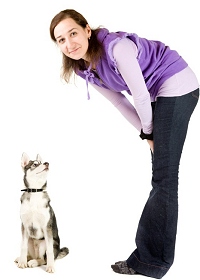Puppy Training Made Easy - 4 Things You Must Do Right
By Michele Welton, Dog Trainer, Breed Selection Consultant, Author of 15 Dog Books

Your puppy's job is to try things – all sorts of things. Your job is to give a thumbs-up or thumbs-down to everything. That's how puppies learn best.
How easy is it to train a puppy?
Most people find it harder than they imagined. Usually they attribute this to some deficiency in the puppy. "He's so stubborn.... doesn't listen.... nips the kids... pees on the floor.... runs away from me outdoors...."
What they don't realize is that it's normal for puppies to try out all kinds of behaviors – to which the owner must respond properly.
Otherwise the pup will develop bad habits and training will become more difficult.
But training your puppy doesn't have to be a struggle. There are four simple things you can do right now to change your pup's behavior and make training easy.
Just be aware that responding properly to everything your puppy does often requires that you change the way you're living with (and interacting with) the puppy.
Incorporating a puppy into your family requires canine-friendly changes to your home, yard, and lifestyle. Some changes need to be made for all pups, while other changes are age-specific, size-specific, or breed-specific.
4 ways to make puppy training easier
1) The first way to make puppy training easier is to confine your pup whenever you're not interacting with him.
It's easier to train a puppy when you don't let him loose in your house.
The FIRST step to indoor calmness and better behavior is to control your puppy's movements in the house.
Puppies should never be allowed to wander freely around the house. Pups who are loose in the house are at high risk of developing bad habits such as excitability, destructive chewing, or eliminating on the floor. Even worse, the pup is at high risk of swallowing something that results in a life-theatening impaction.

If someone isn't interacting closely with the puppy, he should be safely confined. Then he won't develop bad habits or swallow something life-threatening.
Being loose in the house should be a privilege that is s-l-o-w-ly earned – after the puppy matures (at least 10 months old), is 100% housebroken (zero accidents), is calm and quiet indoors, has learned all the rules and routines of your household, and has no behavior issues.
You might think that's a long time to wait. But your pup is going to be with you for 10 to 15 years. Surely you can afford to be ultra-vigilant for just 1 to 2 of those years, thereby ensuring that all the remaining years will be problem-free.
How to control your puppy's movements indoors:
- If he is not 100% housebroken, he should be in a crate or wire pen whenever you're not interacting with him.
- If he is 100% housebroken, he should be restricted (with portable baby gates) to the same room you're in. Or keep him on a leash so he must follow you around the house as you do chores, or hang out with you when you watch TV or read a book or answer your email.
2) The second way to make puppy training easier is to focus on calmness.
It's easier to train a puppy when you encourage him to be calm and discourage excitability. Especially indoors!
Whenever I'm called in for a behavioral consultation, virtually never do I find a calm, relaxed pup who is ready to learn. Instead I find the pup barking out the windows, rushing the door when the doorbell rings, jumping on people, bounding across the furniture, attacking the vacuum cleaner, pulling on the leash, and dashing through doors ahead of the owner.
Calmness – both physical and mental calmness – is the foundation for all training. It's easier to get good behavior from a pup who knows how to stop moving around and pay attention to you.
On the other hand, it's harder to get good behavior from a puppy who is excitable and reactive. By excitable and reactive, I mean a pup who is easily aroused, quick to respond to whatever he sees or hears, and doesn't relax unless he's asleep.

Calmness (both physical and mental) makes training so much easier. Neither humans nor dogs can learn much when hyped up.
How to instill calmness in your puppy:
- Confine him when you're not interacting with him (see #1 above).
- Teach No and Yes, acceptance of handling, walk nicely on leash, Wait at open doors and gates instead of rushing through, Sit-Stay, and the most effective technique for teaching calmness: the Place command, which teaches the pup to go to his dog bed and remain there until given permission – this valuable exercise teaches calmness, impulse control, and physical and mental relaxation.
- Gently but persistently correct excitable/reactive behaviors indoors.
3) The third way to make puppy training easier is to teach EVERYTHING in my training book, Respect Training for Puppies (available on my website for free).
It's easier to train a puppy when you teach ALL the skills on my list, rather than cherry-picking some and blowing off the rest.
For example, you might be tempted to focus on commands (such as "Come") while still allowing the pup to race around indoors, bark at visitors, jump on people, demand petting and attention, and pull on the leash.
That's not going to work.
Allowing excitable, impulsive, or disrespectful behavior keeps a puppy in an excitable, impulsive, and disrespectful mindset. This state of mind is stressful for a puppy to live with and virtually guarantees more behavior problems in the future.
So commit to working on each skill on the list. They're all important in encouraging calm, respectful behavior and discouraging excitable or disrespectful behavior.
4) The fourth way to make puppy training easier is to use the right training method.
It's easier to train a puppy when you use a balanced training method based on respect and leadership.
When you use the right training method, your puppy will be happy to let you decide what he can and can't do in your family.
When you use the wrong training method, your puppy will begin making decisions about how he wants you to fit into his life. That's a recipe for conflict and behavior problems.
So what's the best training method for puppies?
Balanced Training. You reward the good and correct the bad. Sometimes it's called Yes & No Training because you tell your pup Yes for some behaviors, No for others. It's the perfect training method for canines, matching the commonsense way they learn.
- If you add a reward (something your pup likes) to a behavior you want him to do (greeting guests politely, standing still while you brush him, going to the bathroom in the right place), he's more likely to repeat that behavior.
- If you add a correction (something the pup dislikes) to a behavior you don't want him to do (jumping on people, barking, chasing the cat), he'll be less likely to repeat that behavior.
Your puppy needs BOTH thumbs-up feedback and thumbs-down feedback so he can make wise choices.
Even better....
My training method is not only balanced, but also based on respect and leadership.

A puppy who is taught to respect you will pay close attention to you.
- Balanced – Yes and No
- Respect and Leadership
Show your puppy that you're in control of everything in his life and that he should look to you for guidance and direction.
That's leadership.
When you are a calm, confident, consistent leader, your puppy will be very happy to be a respectful follower.
Very happy. The vast majority of dogs want to be followers. But they do expect YOU to live up to your leadership role. If you don't, well....
....without proper respect, your puppy might know lots of words and commands, but choose not to do them. I'm sure you know dog owners who say their pup "understands" them but doesn't do what they say.
Using balanced training based on respect and leadership, you can vastly improve your puppy's behavior. Check out my puppy training book: Respect Training For Puppies (available for free reading on my website – scroll down to read).
My best-selling books – now available FREE on my website
 Respect Training For Puppies: 30 seconds to a calm, polite, well-behaved puppy is for puppies 2 to 18 months old. Your puppy will learn the 21 skills that all family dogs need to know. Click here to read for free.
Respect Training For Puppies: 30 seconds to a calm, polite, well-behaved puppy is for puppies 2 to 18 months old. Your puppy will learn the 21 skills that all family dogs need to know. Click here to read for free. Teach Your Dog 100 English Words is a unique Vocabulary and Respect Training Program that will teach your adult dog to listen to you and do what you say. Click here to read for free.
Teach Your Dog 100 English Words is a unique Vocabulary and Respect Training Program that will teach your adult dog to listen to you and do what you say. Click here to read for free. 11 Things You Must Do Right To Keep Your Dog Healthy and Happy helps your dog live a longer, healthier life. Get my honest advice about all 11 Things before you bring home your new puppy, because some mistakes with early health care cannot be undone. Click here to read for free.
11 Things You Must Do Right To Keep Your Dog Healthy and Happy helps your dog live a longer, healthier life. Get my honest advice about all 11 Things before you bring home your new puppy, because some mistakes with early health care cannot be undone. Click here to read for free.
